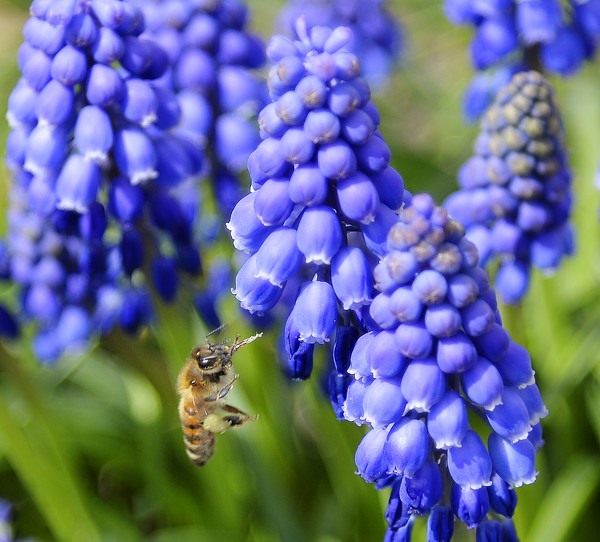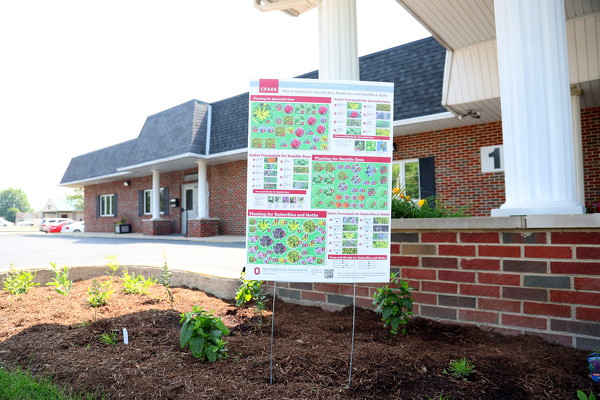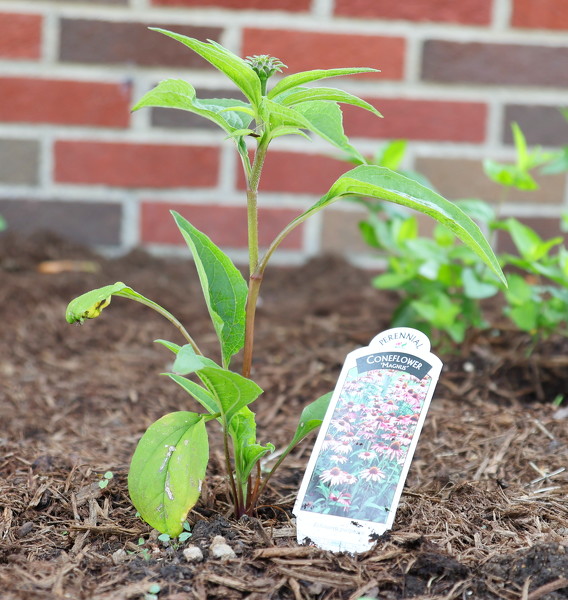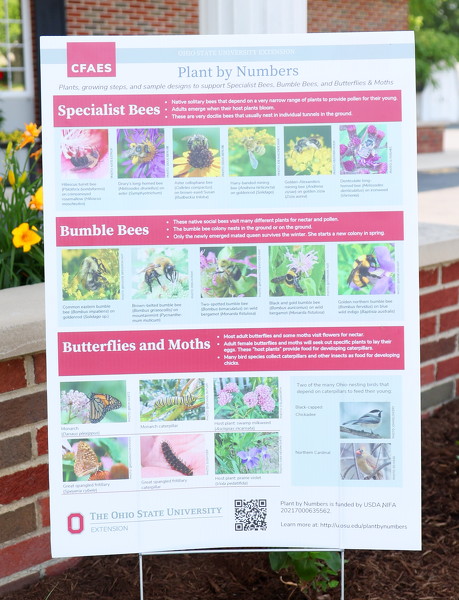
A bee buzzes around a few Grape Hyacinths near Knap's Drive Thru Carryout in Coldwater.
CELNA - A series of pollinator garden plots has taken root in front of the Mercer County Council on Aging Senior Center in Celina, showcasing a variety of fledgling plants that attract and foster different types of specialist bees, bumble bees, butterflies and moths.
It's a model that can be replicated by others interested in supporting pollinators, officials said.
Ryan McMichael, an Ohio State University Extension educator for Mercer County, gave an overview of the project to the newspaper in celebration of National Pollinator Week that runs through Saturday.
Robust, healthy pollinator populations are important for ecosystems, biodiversity, agriculture and the economy at large.
Bees, other insects, birds and bats play a critical role in producing more than 100 crops grown in the United States, according to U.S. Department of Agriculture. USDA says honeybee pollination alone adds more than $18 billion in value to agricultural crops annually.
"There's lots of different bee species. When you start looking at bees that are pollinators, certain ones are attracted to different plants," McMichael said. "We have ones that do better jobs than others in terms of pollinating."

The Mercer County Council on Aging in Celina.
In coordination with USDA, OSU Extension received a grant to establish pollinator plots at the senior center to draw and nurture bees, butterflies and moths, McMichael said. Signs providing details about the plants were also erected.
"Our master gardeners helped plant them along with the staff at the senior citizen center," he said. "So that's out there and people are more than welcome to go out and see some of the information."
There are three plots designed for bumble bees, specialist bees and butterflies and moths. McMichael hopes the plots inspire others to create their own pollinator habitats, no matter how small.
"More and more folks are interested because … the research says we have a decline in the honeybee population and we have the decline in other pollinators," he said. "So the interest is there of 'how do we stop these declines and what can we do?'"
Successful pollinator habitats such as small garden plots contain a variety of different plant species.
"It's not probably your traditional-looking landscape of nicely manicured (plants)." McMichael said.
Ohio is home to about a dozen species of bumble bees, nearly half of which are commonly observed in gardens and natural areas, according to an OSU Extension handout.
They're social bees who live together in a colony that is active less than a year. Each colony, the handout states, is started anew in early spring by an overwintering queen.
"Because they are active for many months of the year, bumble bees need to find plants with a progression of bloom to ensure they have enough pollen and nectar to rear young bees, and enough nectar to fuel adults in flight," the handout reads.
Workers visit different species of plants to gather pollen and nectar, including herbs, garden flowers, weeds and trees. To attract bumble bees, OSU Extension recommends planting a 6-by-12-foot garden with four butterfly milkweed plants, one blue wild indigo plant, three purple coneflower plants, six tall blazing star plants, three scarlet beebalm plants, three clustered mountainmint plants, three rough goldenrod plants, six prairie dropseed plants and four smooth blue aster plants.

A Magnus flower grows in a pollinator garden in front of Mercer County Council on Aging in Celina.
According to OSU extension are more than 140 species of butterflies and over 2,000 species of moths have been observed in the state. Most adult butterflies and some moths visit flowers for nectar, carbohydrate-rich foods that fuel flight and other activities.
In addition to pollinating plants, caterpillars and adult butterflies serve as food for birds and their young.
To attract butterflies and moths, OSU Extension recommends planting a 6-by-12-foot garden with six swamp milkweed plants, four Appalachian sedge plants, two perennial sunflowers, four hairy beardtongue plants, three lanceleaf tickseed plants, three short's goldenrod plants, three New England aster plants, five prairie violet plants and three golden zizia plants.
"Be on the lookout for caterpillar activity, and learn to tolerate leaf feeding to support these important creatures," the handout states. "To attract even more butterflies and moths to the garden, consider providing water, sandy areas for puddling, and even a feeder for rotting fruit."
OSU Extension says roughly one-third of all bee species are pollen specialists that use pollen only from a narrow range of native plants as food for developing bee larvae. About 100 species of wild bees in the state are believed to be pollen specialists. Specialist bees are solitary insects.
"Adult specialist bees are active for only a few weeks of the year, in sync with the bloom time of their pollen host plants," the handout states. "Specialist bees will not nest in an area without their host plants. Once host plants are added to gardens and other settings, these bees will often find their favorite flowers and might decide to nest nearby."
To attract specialist bees, OSU Extension recommends planting a 6-by-12-foot garden with one perennial sunflower, six scarlet beebalm plants, three hairy beardtongue plants, three clustered mountainmint plants, four rough goldenrod plants, four smooth blue aster plants, four narrowleaf ironweed plants and three golden zizia plants.
For more information on pollinator habitats, visit u.osu.edu/plantbynumbers/resources-for-butterflies-and-moths.

Pollinators such as specialist bees, bumble bees, butterflies and moths are great for the ecosystem.
Farm Service Agency has created a new initiative called the Ohio Pollinator and Monarch State Acres for Wildlife Enhancement.
Producers will receive annual rental payments for the length of a contract and cost-share assistance of up to 50% of the eligible practice cost to establish pollinator habitats, according to an FSA news release.
Mercer County is one of the counties eligible for the program that aims to enhance and restore habitat for ecologically and economically significant pollinator species.
"The goal of this project is to increase the amount of appropriate habitat for the monarch butterfly and other pollinators in Ohio," the release states. "The enrolled habitat, a mix of grasses and forbs, will provide important nectar sources as well as the required larval host plant species. Because of the significant decline in monarch numbers, both range-wide and in Ohio, the monarch butterfly is the focus of this project."
However, other pollinator species are expected to benefit from implementation of the project.
For more information contact Mercer County FSA at 419-586-3149.
"Our world's ecosystem and food supply greatly rely on pollinators -without them, many of our nation's crops wouldn't be able to produce as many fruits, nuts or vegetables resulting in lower supplies and higher prices," said U.S. Agriculture Secretary Tom Vilsack in a statement. "This week and every week, it is critically important that we continue to encourage the protection of pollinators and their habitats. Fewer pollinators harm both farm income and nutrition security for many Americans. Healthy pollinator populations are essential to the continued success and well-being of agricultural producers, rural America and the entire U.S. economy."

